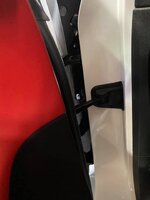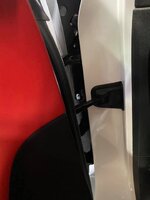Announcement C8 Problems thread
- Thread starter Morgan
- Start date
You are using an out of date browser. It may not display this or other websites correctly.
You should upgrade or use an alternative browser.
You should upgrade or use an alternative browser.
More cases now being revealed now that guys are looking for it. So far always drivers door ...if this is true them GM should be notified immediately
So first thing we should do is trim that bolt somehow if GM doesn't address it?
I would agree. I’ve contacted my dealer as mine is in transit and Warned them about this so nobody at dealership opens door fully until this is 100% checked.

2020 Corvette May Already Have A Design Flaw
The all-new 2020 Chevrolet Corvette Stingray is now arriving in dealerships and the driveways of the first group of customers. Production has temporarily been halted at the Bowling Green, Kentucky assembly plant due to the coronavirus pandemic, but that obviously isn't preventing those new...
Regarding the water getting in the engine bay due to big vents/holes in the hatch:
I took a look at many of the mid-engine cars that were built over the years. Every single one I looked at (from the Fiat X1/9, Toyota MR2, all the way up to the McLaren P1 and an unmentionable American mid-engine car from the '80s) have cutouts/vents above the engine in the rear of the car. This is very likely due to heat buildup as an engine in the rear of the car will get a lot less moving air/ventilation than one mounted up front. The front of the car is a high-pressure area and the rear is low-pressure. Air will want to move away from the front but collect at the rear. Gotta do as much as you can to keep the heat out.
No one in our wealth bracket would have noticed this before because, frankly, who bought a Toyota MR2, Fiat X1/9 or *cough-Fiero-cough*? Until the C8 came out, the only mid-engine cars you could get were $300k or more. It wasn't common knowledge that rear hatches for these cars had big vents and cutouts.
The convertible will also have big vents in the rear hatch. It just won't be as obvious that water gets in because, really, who's going to look at the engine bay in the convertible?
We're just going to have to deal with it...
Side note: I think if someone reaches out to a detailing business that caters to high-end imports, they may have some suggestions on how to prevent water from getting into the engine bay.
I took a look at many of the mid-engine cars that were built over the years. Every single one I looked at (from the Fiat X1/9, Toyota MR2, all the way up to the McLaren P1 and an unmentionable American mid-engine car from the '80s) have cutouts/vents above the engine in the rear of the car. This is very likely due to heat buildup as an engine in the rear of the car will get a lot less moving air/ventilation than one mounted up front. The front of the car is a high-pressure area and the rear is low-pressure. Air will want to move away from the front but collect at the rear. Gotta do as much as you can to keep the heat out.
No one in our wealth bracket would have noticed this before because, frankly, who bought a Toyota MR2, Fiat X1/9 or *cough-Fiero-cough*? Until the C8 came out, the only mid-engine cars you could get were $300k or more. It wasn't common knowledge that rear hatches for these cars had big vents and cutouts.
The convertible will also have big vents in the rear hatch. It just won't be as obvious that water gets in because, really, who's going to look at the engine bay in the convertible?
We're just going to have to deal with it...
Side note: I think if someone reaches out to a detailing business that caters to high-end imports, they may have some suggestions on how to prevent water from getting into the engine bay.
From what I have read they have not had time to set up a remedy line for this due to the launch and this world issue going on right now but hopefully it will be something that they will look at when stuff calms down and we return to some kind of normalI hope GM is aware of this and making the necessary fix.
When they run out of the bolts they have they might put the right ones in. LOL.
Water leaks have and will be every manufacturer worst nightmare. All plants have a facility that all vehicle pass through the water test booth; vigorous high powered pressured water is sprayed all over the vehicle and checked internally with a blue light. The water pressure given is more than a normal thunderstorm or monsoon. If leaks are detected, repairs are done accordingly, unfortunately, these repairs are just that repairs and are subjected to leak again thereafter. Prototype vehicles before sign off for mass production are off perfect assembly.Regarding the water getting in the engine bay due to big vents/holes in the hatch:
I took a look at many of the mid-engine cars that were built over the years. Every single one I looked at (from the Fiat X1/9, Toyota MR2, all the way up to the McLaren P1 and an unmentionable American mid-engine car from the '80s) have cutouts/vents above the engine in the rear of the car. This is very likely due to heat buildup as an engine in the rear of the car will get a lot less moving air/ventilation than one mounted up front. The front of the car is a high-pressure area and the rear is low-pressure. Air will want to move away from the front but collect at the rear. Gotta do as much as you can to keep the heat out.
No one in our wealth bracket would have noticed this before because, frankly, who bought a Toyota MR2, Fiat X1/9 or *cough-Fiero-cough*? Until the C8 came out, the only mid-engine cars you could get were $300k or more. It wasn't common knowledge that rear hatches for these cars had big vents and cutouts.
The convertible will also have big vents in the rear hatch. It just won't be as obvious that water gets in because, really, who's going to look at the engine bay in the convertible?
We're just going to have to deal with it...
Side note: I think if someone reaches out to a detailing business that caters to high-end imports, they may have some suggestions on how to prevent water from getting into the engine bay.
Most common faults for leakage are bent flanges overuse of sealer poor welds or adhesion to parts and poor installations of weather stripping. Proper maintenance to these vital areas of possible leakages falls onto the owners to the due diligence of proper maintenance.
I love my dremel, but it usually doesn't go well when I use it. LOL.Ya ya....blame it on the assembler. Typical North American mgmt response!
Maybe the bolt was engineered to act as a 'stop', and it's too short.......lol.
Doesn't anyone have a dremel?
There's open vents ffs. How can water NOT get in? My C7 has wet spots in the engine bay after I put the hose to it. I wipe them dry. If I want the plastic shrouds to shine, I'd put the ArmorAll (or similar) to it. The C8 is no different, except for location (and the need for a dremel).
that was why i tried to get a convertibleThere's open vents ffs. How can water NOT get in? My C7 has wet spots in the engine bay after I put the hose to it. I wipe them dry. If I want the plastic shrouds to shine, I'd put the ArmorAll (or similar) to it. The C8 is no different, except for location (and the need for a dremel).
that was why i tried to get a convertible
Still open vents with the convertible. Just can't see the engine bay when everything's closed or the trunk is open.
The water coming in the engine bay area is normal and won't hurt anything. I've been pressure washing all my engines for many many many many many years and have NEVER had one problem.
Even Ferrari's have the vents in the back and water gets in. Its normal, just add it to your regular cleaning routine and move along.
Even Ferrari's have the vents in the back and water gets in. Its normal, just add it to your regular cleaning routine and move along.
Out of sight out of mind so they say.Still open vents with the convertible. Just can't see the engine bay when everything's closed or the trunk is open.

Similar threads
-
-
-
Are GM extended splash guards and PPF enough protection for rockers?
- Started by C8PITT
- Replies: 8
-
-
Users who are viewing this thread
Total: 1 (members: 0, guests: 1)

